
Aegires punctilucens
(d'Orbigny, 1837)
Order: NUDIBRANCHIA
Suborder: DORIDINA
Superfamily: ANADORIDOIDEA
Family: Aegiretidae
DISTRIBUTION
Mediterranean & coast of western Europe to western Norway. Also found in Japan, Australia.
PHOTO
Echizen-coast, Wakasa Bay, Japan, depth: 4m, 10 July 2002. Size approx: 7mm. Photo: Jun Imamoto
Body is typical in shape for the genus. It is spiculate and rigid with numerous spiculate tubercles, each with a large flattened tip. The rhinophores are smooth and rod-like and emerge from a prominent raised sheath with 3 -5 large tubercles around the opening. The gills also are protected by a raised gill sheath which is divided into three multituberculate branches. The animal is translucent brown in colour with scattered spots and patches of white. There are also bright blue spots arranged in a symmetrical pattern over the body. Most of the spots are surrounded by a broad orange-brown ring. It grows to approx 20mm in length. On its food sponge it is very well camouflaged. In Europe it feeds on the calcareous Leucosolenia botryoides.
An animal extremely similar in colour and appearance to this European species is apparently not uncommon in Japan, and I have some records of it from eastern Australia. Presumably this disjunct distribution is the result of human activity, but as with many of these occurrences, the original home of the species is unclear. [See radula of eastern Australian animal.]
References:
• Baba, K. (1974) New distributional record of Aegires punctilucens (d'Orbigny, 1837) from Sado Island, Japan (Nudibranchia: Doridoidea: Aegiretidae). The Veliger, 17(1):11-12.
• D'Orbigny, A. 1837. Memoire sur des especes et sur des genres nouveaux de l'ordre des nudibranches, observes sur les cotes de France. [Guerin's] Magasin de Zoologie, (7. Class 5): pp. 1-16, pls. 102- 109.
• Schmekel, R. L., & Adolf Portmann. (1982) Opisthobranchia des Mittelmeeres, Nudibranchia und Saccoglossa. Fauna e flora del Golfo di Napoli 40, Monografia della Stazione Zoologica di Napoli. pp. i-viii, 1-410, pls. 1-36. Springer-Verlag
• Templado, J., A. A. Luque, & Jesus A. Ortea. (1987) A new species of Aegires Loven, 1844 (Opisthobranchia: Doridacea, Aegiretidae) from the Caribbean Sea: Aegires ortizi spec. nov., with comparative descriptions of the North Atlantic species of this genus. The Veliger, 29(3): 303-307.
• Thompson, T.E. & Brown, G.H. (1976) British opisthobranch molluscs. Mollusca: Gastropoda Synopses of the British fauna (new series), no 8. Linnean Society, London.
• Thompson, T.E. & Brown, G.H. (1984) Biology of Opisthobranch Molluscs, Vol 2. 1-229 Ray Society: London. 156pp.
Rudman, W.B., 2003 (January 22) Aegires punctilucens (d'Orbigny, 1837). [In] Sea Slug Forum. Australian Museum, Sydney. Available from http://www.seaslugforum.net/find/aegipunc
Related messages
Re: Are Aegires punctilucens and A. exeches the same?
September 29, 2009
From: David Kipling
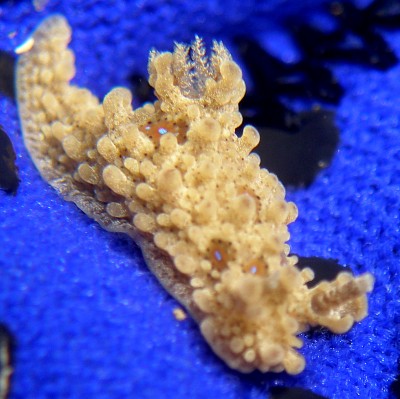
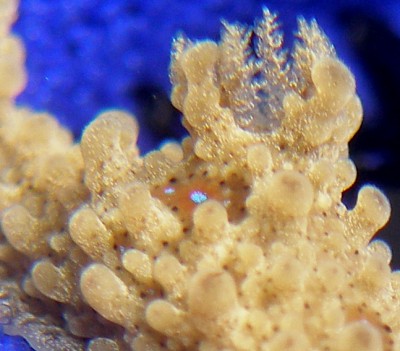
Concerning message #14248:
Dear Bill,
In response to your request for some pictures of Atlantic specimens of Aegires punctilucens please find enclosed some photographs of a specimen taken in the UK a couple of months ago.
The bright blue background to two of the pictures is my wetsuit glove. The animal was then released back onto it original turf, giving the third photograph. It may have been a bit "stressed" by this man-handling, but seem to be pretty active afterwards and crawled away at some speed.
Locality: Castlemartin, Pembrokeshire, 51o 36.101 N 004o 57.720W, 10 m, United Kingdom, Atlantic, 21 June 2009, Limestone bedrock covered with red weed, hydroids, and dense ascidian turf. Photographer: David Kipling.
I have included photographs where the focal plane is both centred on the rhinophores, and on the gills. I hope these photos are of some help.
Best regards
David Kipling,
Cardiff UK
plankton@dircon.co.uk
Kipling, D., 2009 (Sep 29) Re: Are Aegires punctilucens and A. exeches the same?. [Message in] Sea Slug Forum. Australian Museum, Sydney. Available from http://www.seaslugforum.net/find/22608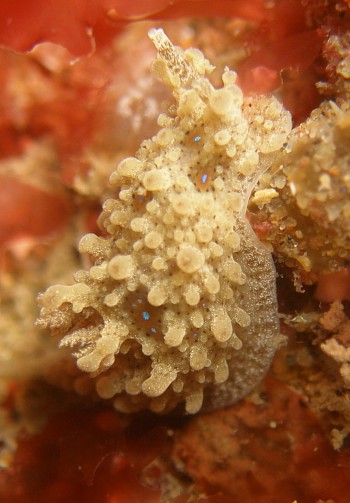
Dear David,
Thanks for these photos of an animal from the UK. The colour pattern is remarkably similar to the photo of a Japanese specimen I have on the species' Fact Sheet.
This only reinforces my feeling that A. exeches is an unnecessary name for animals from the Indo-West Pacific. I guess this is another species which now has a circumglobal distribution courtesy of the worldwide shipping. It will be interesting to see if DNA technology will be able to determine whether this is an Atlantic species which has hitched a ride to the Indo-West Pacific or vice versa.
Best wishes,
Bill Rudman
Aegires punctilucens from Norway
July 18, 2005
From: Bill Rudman
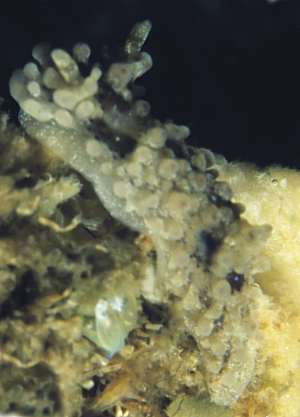
Jussi Evertsen has kindly sent me a larger scan of the photo of Aegires punctilucens that I mentioned earlier [message #14248] was on the website: Nudibranchia on the coast of central Norway.
Location: Kvenvær, Hitra [west coast of Norway] April 2001, found by Torkild Bakken It is very well camouflaged amongst the sponge Leucosolenia botryoides. Photo: Jussi Evertsen.
It certainly has similarities to the photo of an animal from Sydney [message #14229]. For example, there is a symmetrical pattern of spaces, clear of tubercles, and the blue-green spots are surrounded by brownish yellow and black spots. In this animal the scattered opaque white specks are clearly the same as the whitish glands in the Sydney animal.The right rhinophore seems to be developing a bifid tip.
Thanks Jussi,
Bill Rudman
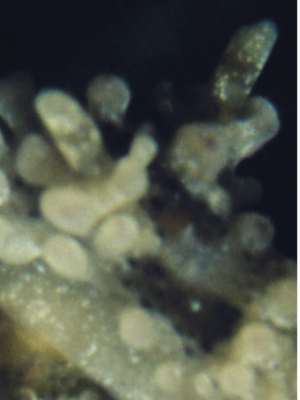
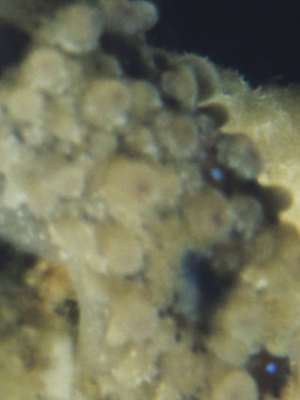
Aegires exeches is a distinct species
July 13, 2005
From: S. Fahey & T. Gosliner
Dear Bill,
Thanks very much for posting the recent messages regarding Aegires. You're right about how science advances by exchanging ideas and publishing testable hypotheses. It's one of the most dynamic aspects of science and can be the most stimulating part of our work. I have posted our comments on the family name in a separate message [#14254 ].
Concerning your comments on whether Aegires exeches and Aegires punctilucens are distinct species [message #14248 ]. We think that the two can be distinguished externally, although the internal morphology is where the greatest differences lie.
1. Dorsal tubercles: Aegires punctilucens has far more densely packed dorsal tubercles than are found in Aegires exeches. These tubercles are clearly mushroom-shaped in A. exeches as opposed to the flattened or rounded tops of the tubercles of A. punctilucens that do not extend outwards from the base. We think that the photos you have posted of the Sydney harbor specimens may indeed be A. exeches, but could also have been A. punctilucens introduced from Europe. Also, the tubercles of A. exeches have far more spicules that protrude substantially such that the animal has a "fuzzy" appearance. The tubercle character states utilized for our analyses (#5, #6) were coded the same for A. exeches and A. punctilucens so the tree topology was not affected by this character. All the photos on the web (including Picton's very nice photo), d'Orbigny's drawing and Alder and Hancock's drawing do not show spicules that protrude significantly as in A. exeches specimens from the Indo-Pacific.
2. Rhinophore shape: Although the bifid tip may be apparent in some older (larger) specimens of A. punctilucens, this character (#10) was not included in the final phylogenetic analysis, so it had no effect on the outcome of the tree topology.
3. Rhinophoral tubercles: In A. punctilucens the rhinophoral tubercles are simple while in A. exeches there are secondary branches on the base of the larger tubercles
4. Gill protective appendage: The more elaborate gill appendage found in A. exeches differs from A. punctilucens. The Japanese specimen displays this elaboration, as does the specimen from Sydney harbor, which as we note above, may indeed be A. exeches. We don't believe that the photo of Bakken and Evertsen (2004) is of A. exeches although the gill appendage has a similar, though distinct morphology. This character did not influence the result of the analysis, since both species were coded with the same character state (#20, #61).
5. Color: We agree that some Atlantic specimens would have been nice to examine for our study, but we wanted to present the information at hand in our publication. As always, any contributions of specimens and discussion are welcome! Nevertheless, the dorsal color characters including the ocellae (#54, #55, #57) were all coded as similar states for the two species and thus did not affect the outcome of the phylogeny presented.
6. Reproductive system: We agree that Schmekel and Portmann's (1982) drawing on page 99 is diagrammatic, but we used their rather detailed drawing on page 389 as a comparison for the specimens we examined. There are several reproductive differences between the Indo-Pacific (A. exeches) and Atlantic (A. punctilucens ) specimens. To summarize from our publication:
a) The receptaculum seminis attaches at a different point on the vagina in each of the two species A. exeches vs. A. punctilucens (at the base of the bursa vs. directly into the vaginal duct);
b) The distal end of the vagina has a very different morphology between the two species (long and narrow vs. short, large and bulbous),
c) The vaginal duct morphology (long and straight vs. short and curved),
d) The prostate (curved and wide vs. very thick and straight) and
e) The ampulla (narrow and slightly curved vs. thick and tightly bowed).
f) Penial bulb (short and narrow vs. long and very thick with a distinct distal thickening)
7. Radular morphology: Schmekel and Portmann's drawing shows a much wider tooth shape than we found in the Indo-Pacific specimens, which all had much narrower, "candy cane"-shaped teeth. Although in both species the teeth gradually increase in size outwards, in A. exeches there are at least three substantially smaller, narrower teeth before the teeth gradually increase in size (see Fig. 60C). We provided the radular formula of A. exeches as a comparison for A. punctilucens but radular formula was not used as a character in our phylogenetic analyses to determine the relationships among Aegires.
To summarize, we believe that it is the combination of characters that can be used to distinguish between species, not just one, two or three differences. The data matrix that we used had over 60 characters for consideration.
Finally, we would certainly like to examine specimens from the Atlantic and Mediterranean, or would love to see someone take on the project and publish their results for discussion.
Thanks again for taking the time to critically examine our manuscript, Bill. Regards,
Terry and Shireen
sfahey@calacademy.org
Fahey, S. & Gosliner, T., 2005 (Jul 13) Aegires exeches is a distinct species. [Message in] Sea Slug Forum. Australian Museum, Sydney. Available from http://www.seaslugforum.net/find/14253Dear Shireen,
Thanks for your quick response. I don't want to preclude others from this discussion so I will just make a brief comment at this stage. Its not really a question of what characters you put into your cladistic analysis and how you scored them, it seems to me a question of how little we know about the populations. My point was that shape of the tubercles changes in the daily life of an animal and so does the degree of spicule protusion. I suspect spicules are so obvious in Japanese animals, and the tips of the tubercles so flattened out, because they have been photographed undisturbed in the field. My photos were of animals in the lab, and I am sure d'Orbigny's and Alder & Hancock's animals were drawn from animals in dishes, and probably stressed, where tubercles have contracted and only partly expanded. I can't agree with your comment that the radula of A. punctilucens is much broader than the 'thin candy cane' teeth of A. exeches. It is hard to compare the flattened light microscope mount of Schmekel & Portmann with modern SEM photos of the whole ribbon which are viewed from the inner edge, but as you can see in my SEM mount [#9037 ] the large teeth have a broad basal half much as drawn by Schmekel & Portmann
Considering that every other species of Aegires can be identified from its colour pattern, I feel that the fact that Atlantic animals of A. punctilucens could easily fit into the variation found in Pacific populations should ring alarm bells. The only real anatomical difference is found in the reproductive system. Since only one Atlantic specimen and one Pacific specimen of these tiny animals has been examined I think we should first consider the possibility the one of the anatomical descriptions is incorrect.
Best wishes,
Bill Rudman
Aegires punctilucens from Sydney
July 12, 2005
From: Bill Rudman
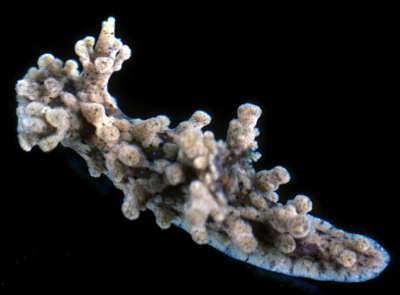
To accompany my discussion [message #14248] on Aegires punctilucens and A. exeches here are some photos of an animal from Sydney I have posted a photo of it before [message #9052] but these show some of the details more clearly.
Locality: Green Point, Sydney Harbour, NSW, Australia, c 9 m. 10 June 1978. AM C110117. Photo: R & A Kuiter .
It has a symmetrical arrangement of the tubercles and the colour pattern is clearly visible in the spaces between the tubercles. In the lower right photo showing the rhinophore the bifid tip is visible. Also visible in this close-up are small opaque whitish granules which I suspect are the white specks illustrated by d'Orbigny.
Of particular interest are the shape of the tubercles. Most are rounded at the tip but a few are flattened. Look at the bottom right tubercle in lower left photo, and at the tubercle closest to the viewer on the rhinophore sheath in the lower right photo. The tubercles can change shape within a few minutes, and similarly sometimes protruding spicules are quite obvious and at other times there is no sign of their presence.
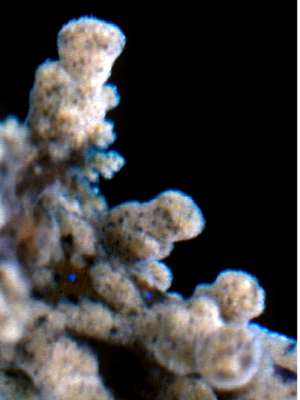
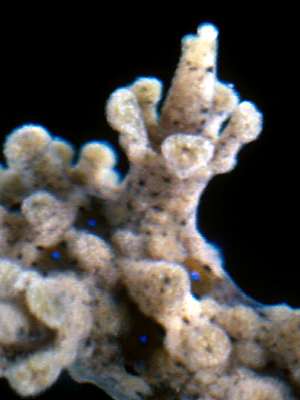
Aegires punctilucens- original illustrations
July 12, 2005
From: Bill Rudman
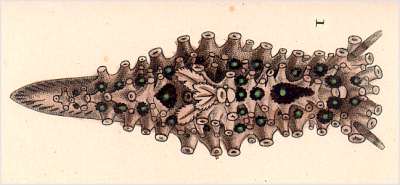
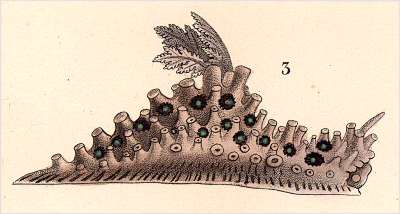
To accompany my discussion [message #14248] on Aegires punctilucens and A. exeches here are two of the original illustrations of A. punctilucens from D'Orbigny (1837: Fig 106, figs 1, 3).
These show the symmetical arrangement of the pustules, which have a flattened tip, and the chracteristic blue or greenish spots, each surrounded by a brownish patch which is outlines with small black spots.
-
D'Orbigny, A. 1837. Memoire sur des especes et sur des genres nouveaux de l'ordre des nudibranches, observes sur les cotes de France. [Guerin's] Magasin de Zoologie, (7. Class 5): pp. 1-16, pls. 102- 109.
Aegires punctilucens - Alder & Hancock's illustrations
July 12, 2005
From: Bill Rudman
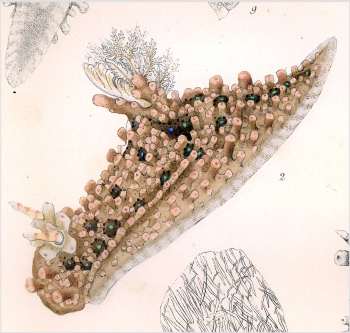
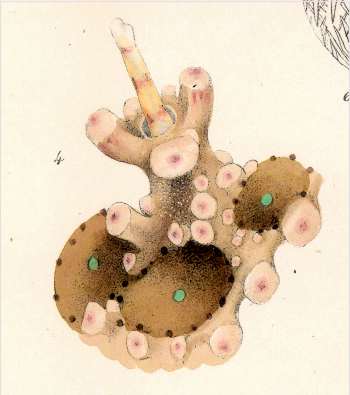
To accompany my discussion [message #14248] on Aegires punctilucens and A. exeches here are two of Alder & Hancock's illustrations of a specimen he described from England to compare with the original illustrations of A. punctilucens from D'Orbigny (1837: Fig 106, figs 1, 3) [message #14230].
The figures [Pl 21, figs, 2, 4] show that the flattened tubercles in d'Orbigny were probably exaggerated but Alder & Hancock again show the characteristic coloured spots, with black dots around the edge of the brownish band. Of particular interest is the clearly bifid tip to the rhinophore, which Alder & Hancock mention in the text and which Fahey & Gosliner state is characteristic of the Indo-West Pacific A. exeches but is absent in the Atlantic A. punctilucens.
- Alder, J. and Hancock, A. (1845) Part 1, for 1844: A monograph of the British Nudibranchiate Mollusca: with figures of all the species. pp. Fam. 1, pls. 4, 5, 26; Fam. 3, pls. 3, 21, 24, 26, 34-36. (The Ray Society: London.)
Bill Rudman
Rudman, W.B., 2005 (Jul 12) Aegires punctilucens - Alder & Hancock's illustrations. [Message in] Sea Slug Forum. Australian Museum, Sydney. Available from http://www.seaslugforum.net/find/14231Are Aegires punctilucens and A. exeches different?
July 12, 2005
From: Bill Rudman
While reading Fahey & Gosliner's (2004) interesting paper on Aegires I was puzzled by one of their new species, Aegires exeches. This is the animal from the Indo-West Pacific which many authors have identified with the Atlantic species Aegires punctilucens. After carefully reading their description and arguments I can't agree that there are grounds for considering there to be two species. For further information, I have posted, in separate messages, copies of d'Orbigny's illustrations [#14230] and Alder & Hancock's [#14231] of A. punctilucens.
It is probably best to address each of Fahey & Gosliner's reasons in the order they appear in the remarks section of their description of A. exeches [pp 659-660].
Body shape: "A. exeches has a very elongate body with extremely elevated, unique tubercles ... they are nearly mushroomed shaped, with a flat crown and completely cover the dorsum." From photos on the Forum, including ones I have just posted [#14229 ], the tubercles of Indo-West Pacific animals are spaced in quite regular arrangements, and the typical colour pattern, which is on the dorsum, is hardly ever obscured. More importantly, the shape of the tubercles is plastic, sometimes a tubercle will be rounded at the tip, but it is capable of opening out to form a flattened top [see #14229]. This would also explain the difference in tubercle shape in d'Orbigny's and Alder & Hancock's illustrations of A. punctilucens.
Rhinophore shape: "rhinophores of A. exeches have bifid apices whereas ... A. punctilucens do not" Alder & Hancock's illustration shows that A. punctilucens can have bifid apices, identical to those of the Indo-West Pacific animal. It is possible that this bifid tip only occurs in larger animals or perhaps the rhinophore has to be fully extended before it is visible, but whatever the situation, it has definitely been reported in both Atlantic and Pacific populations.
Gill protective cover: "A. exeches has a very elaborate, lobed gill structure ..... A. punctilucens has three simple tubercles". Fahey & Gosliner rely on Schmekel & Portmann's (1982) illustration to define this character but there seems to be considerable variation in this character from a simple three small tubercles to the elaborate raised structure found in some Japanese specimens [message #9012], which is essentially 3 tubercles on a raised platform. The photo of the holotype of A. exeches [see Fact Sheet] and the animal from Sydney [see #14229] are essentially three large lobes and are no different from the arrangement seen in a specimen from Norway illustrated by Bakken & Evertsen (2004).
Colour: Fahey & Gosliner consider A. punctilucens has many more iridescent eye spots than A. exeches, but the number and size of these spots is very variable as can be seen in two specimens from Japan photographed by Jun Imamoto [#9013 - many small spots] and [#9012 - few large spots]. The colour of the spot ranges from blue to green, and the surrounding band ranges from orange to light brown in both the Atlantic and the Pacific. Small black spots around the edge of the brownish band are also present in all populations. The only character I am not sure of is the presence of small white spots in some Atlantic specimens. Such spots are present in some Pacific specimens as well [#9012] but are not always obvious.
Reproductive system: It is unfortunate that Fahey & Gosliner had no Atlantic specimens, so they could not directly compare Atlantic specimens with Pacific material. Considering the very diagrammatic drawings of Schmekel & Portmann I would think it is important to re-examine the anatomy of a number of specimens from both the Atlantic and the Pacific before we can be sure there are consistent differences.
Radula: "Schmekel & Portmann illustrate an inner lateral tooth which is much smaller than the rest of the teeth in the row. They also state that the teeth increase in size outwards. In A. exeches, the first three radular teeth are smaller than the remaining teeth." I think Fahey & Gosliner misinterpret Schmekel & Portmann's description. Schmekel & Portmann only illustrate tooth 1 and tooth 10 but their description does not say tooth 1 is much smaller than the rest, they say in fact that they graduallly increase in size. Templado et al (1987) illustrate the radula of A. punctilucens and it shows, as in most species of the genus, a few smaller inner teeth gradually increasing in size to a maximum about two-thirds of the way out and then a small decrease in size. I have discussed this in an earlier message [#9037] where I posted SEM photos of the radula of a southeastern Australian specimen. These all match the SEM photos of A. exeches on the species Fact Sheet. The difference in radula formula mentioned by Fahey & Gosliner 14 x 11.0.11 for a 4 mm specimen of A. exeches against Schmekel & Portmann's 16 x 18.0.18 for a 6 mm specimen of A. punctilucens is too little information for comparison. With such small specimens the error in comparing the lengths is insurmountable and one specimen from each population is too small a sample. Templado et al give a formula of 15 x 18.0.18 for a 7 mm long specimen, and my Sydney specimen had a formula of 15.0.15 (unfortunately length unknown). I don't believe there is any good evidence in the radula to separate A. exeches from A. punctilucens.
I may be wrong, but in my opinion we have no evidence to show that the Atlantic and Pacific populations are distinct species. There is considerable variation in tubercle development and colour pattern within the Pacific population, and some animals match Atlantic animals. Combining that with the ability of the tubercles to change shape makes any attempt to differentiate species on fine detail of colour pattern and tubercle development very difficult if not impossible. The differences in body shape and tubercle development we can see in Aegires villosus [see photos on Fact Sheet] suggest that such variability is not uncommon in species of the genus.
I would welcome others comments, and in particular some more information and photos of Atlantic specimens. I would just like to reiterate that I greatly respect Shireen Fahey and Terry Gosliner's work, but there are a couple of aspects of this paper with which I disagree. For those of you watching from the sidelines, this is how our science advances. A scientist's job is to develop and propose new ideas and hypotheses, but we also have a duty to present opposing views when we disagree.
-
D'Orbigny, A. 1837. Memoire sur des especes et sur des genres nouveaux de l'ordre des nudibranches, observes sur les cotes de France. [Guerin's] Magasin de Zoologie, (7. Class 5): pp. 1-16, pls. 102- 109.
-
Fahey, S. J. & Gosliner, T. M. (2004) A Phylogenetic Analysis of the Aegiridae Fischer, 1883 (Mollusca, Nudibranchia, Phanerobranchia) with Descriptions of Eight New Species and a Reassessment of Phanerobranch Relationships. Proceedings of the California Academy of Sciences, 55, (34): 613–689, 82 figs., 4 tables (Appendix).
-
Schmekel, R. L., & Adolf Portmann. (1982) Opisthobranchia des Mittelmeeres, Nudibranchia und Saccoglossa. Fauna e flora del Golfo di Napoli 40, Monografia della Stazione Zoologica di Napoli. pp. i-viii, 1-410, pls. 1-36. Springer-Verlag
-
Templado, J., Luque, A. & Ortea, J.A.. (1987) A new species of Aegires Loven, 1844 (Opisthobranchia: Doridacea, Aegiretidae) from the Caribbean Sea: Aegires ortizi spec. nov., with comparative descriptions of the North Atlantic species of this genus. The Veliger, 29(3): 303-307.
Best wishes
Bill Rudman
Aegires punctilucens from Japan (2)
January 29, 2003
From: Jun Imamoto
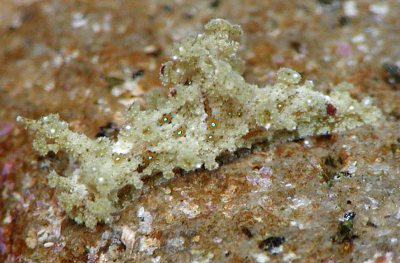
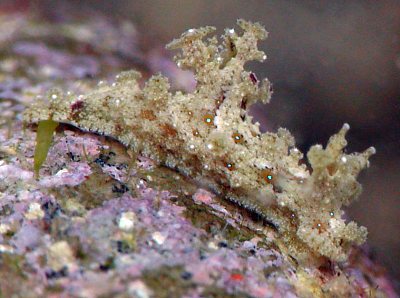
Dear Bill,
Here is some more photos of Aegires punctilucens, from Japan.
They were found on seaweed covered rocks.
Data: Futou, Suruga Bay, Japan. 22 Sep 2002.
Size approx: 5mm
Depth: 2m
Temperature: 25C
Photos: Jun Imamoto
Best Regards,
Jun Imamoto
http://umiushi.zive.net/
imamoto@wips.co.jp
Imamoto, J., 2003 (Jan 29) Aegires punctilucens from Japan (2). [Message in] Sea Slug Forum. Australian Museum, Sydney. Available from http://www.seaslugforum.net/find/9013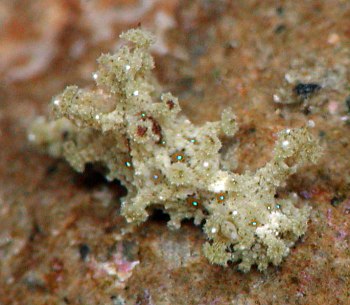
Thanks Jun,
Bill Rudman
Radula of Aegires punctilucens from Australia
January 28, 2003
From: Bill Rudman
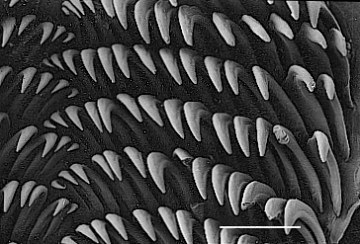
There has been some debate over the identification of the Mediterranean and western European species Aegires punctilucens from Japan. I have also found very similar-looking specimens in eastern Australia. Templado et al (1987) while comparing north Atlantic species considered that the species from Japan was different from the Atlantic species:
'mainly in radula features. ... the outer and inner teeth are similar in Japanese specimens, whereas the Atlantic specimens have the outer teeth thicker than the inner ones',
Here are some photos of the radula of an animal from eastern Australia showing a similar radular morphology to that described for Atlantic specimens.
PHOTOS: Scanning electron micrographs of the radula of an animal from Woody Hd, nr Iluka, nthn New South Wales, Australia. AM C103308. Scale bars: Upper - 100 microns. Lower - 10 microns. Photos: G. Avern.
• Templado, J., A. A. Luque, & Jesus A. Ortea. (1987) A new species of Aegires Loven, 1844 (Opisthobranchia: Doridacea, Aegiretidae) from the Caribbean Sea: Aegires ortizi spec. nov., with comparative descriptions of the North Atlantic species of this genus. The Veliger, 29(3): 303-307.
Best wishes,
Bill Rudman
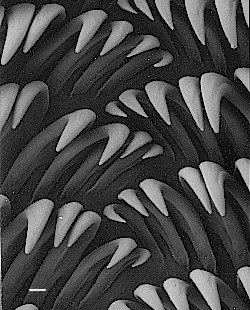
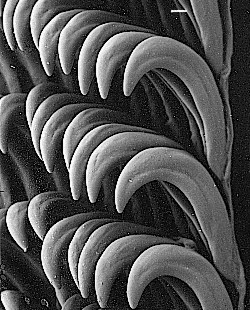
Aegires punctilucens from eastern Australia
January 28, 2003
From: Bill Rudman
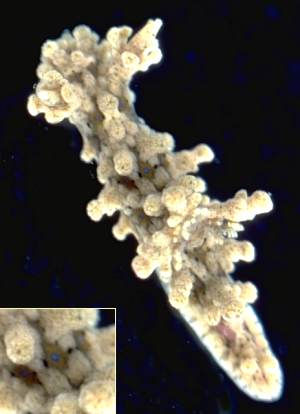
Here is a photo of Aegires punctilucens from eastern Australia, to accompany the other records of this species I have just posted from other parts of the wstern Pacific.
Data: Green Point, Sydney Harbour, NSW, Australia, c 9 m. 10 June 1978. AM C110117. Photo: R & A Kuiter .
Best wishes,
Bill Rudman
Aegires punctilucens from Hong Kong
January 28, 2003
From: Bill Rudman
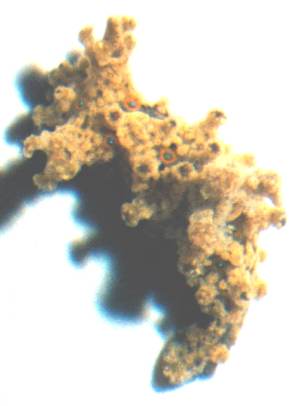
Here is a photo of Aegires punctilucens from Brian Darvell's Hong Kong collections.
PHOTO:
Hong Kong Collection Records:
AM C 139194, 9 April 1983, HK127-2. Photo. Brian Darvell.
Best wishes,
Bill Rudman
Aegires punctilucens from Japan
January 28, 2003
From: Jun Imamoto

Dear Bill,
Here is a sea slug, Aegires punctilucens, which I observed in 2002, which I would like to contribute to the Forum. They are found on seaweed covered rocks. I am happy if these reports are useful for your research.
Echizen-coast, Wakasa Bay, Japan, 10 July 2002. Approx 7mm long, Depth: 4m, Temp: 23C.
Photos: Jun Imamoto
Best Regards,
Jun Imamoto
http://umiushi.zive.net/
imamoto@wips.co.jp
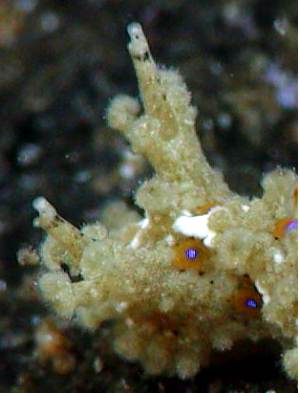
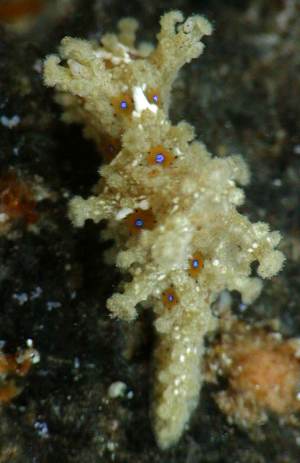
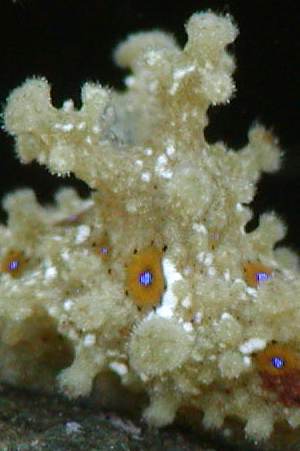
Dear Jun,
Thanks for these photos. This is another of those species with a puzzling distribution. It was originally described from the Mediterranean and is also known from the north Atlantic coast of Europe. As I have discussed on the Fact Sheet, European workers have doubted whether the records of this similar looking species from Japan is the same. I have posted some radula illustrations of an animal from eastern Australia, and photos of another animal from eastern Australia and one from Hong Kong to illustrate the widspread distribution of this animal in the western Pacific.
I have posted a close-up alongside which shows the spiculate nature of the skin, the flattened tips to the tubercles, and the characteristic blue spots, ringed with ornage-brown.
Best wishes,
Bill Rudman
